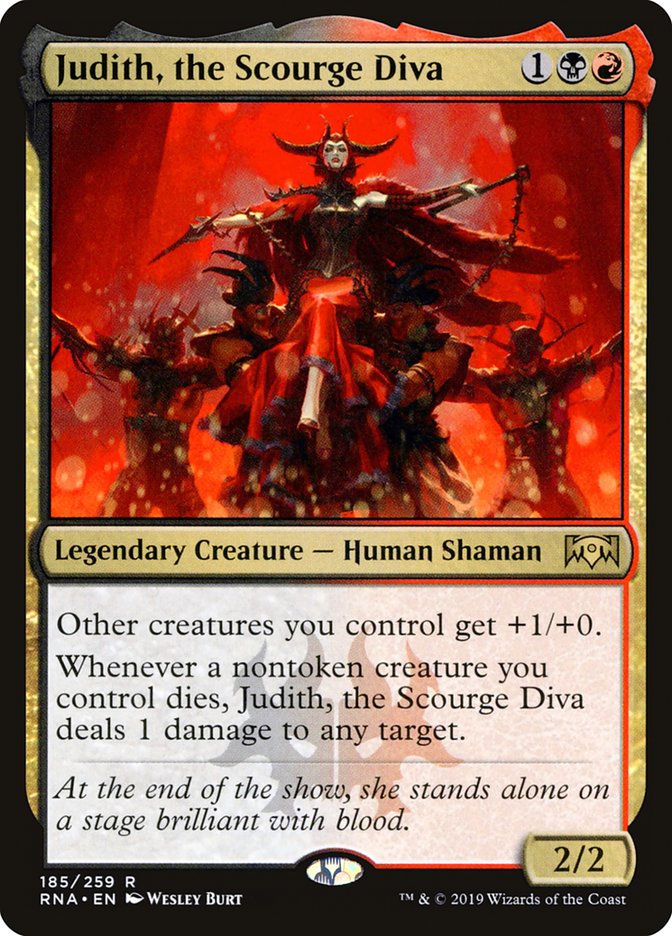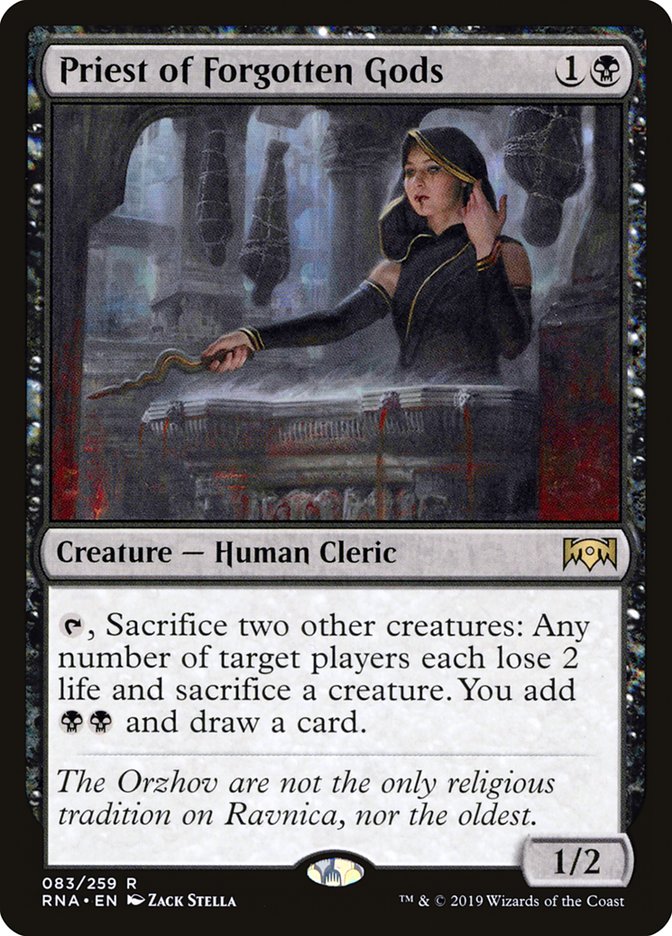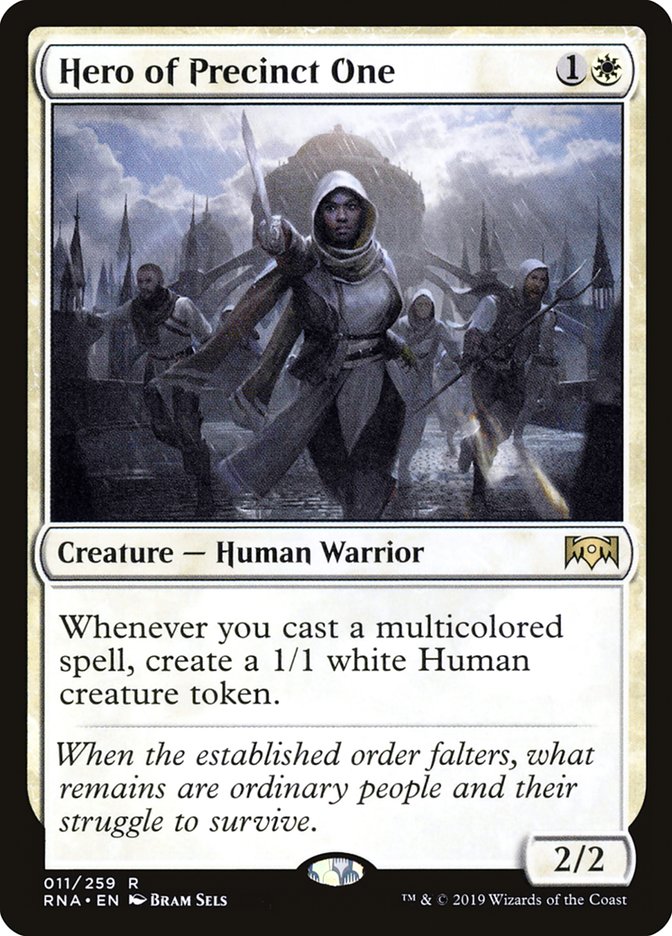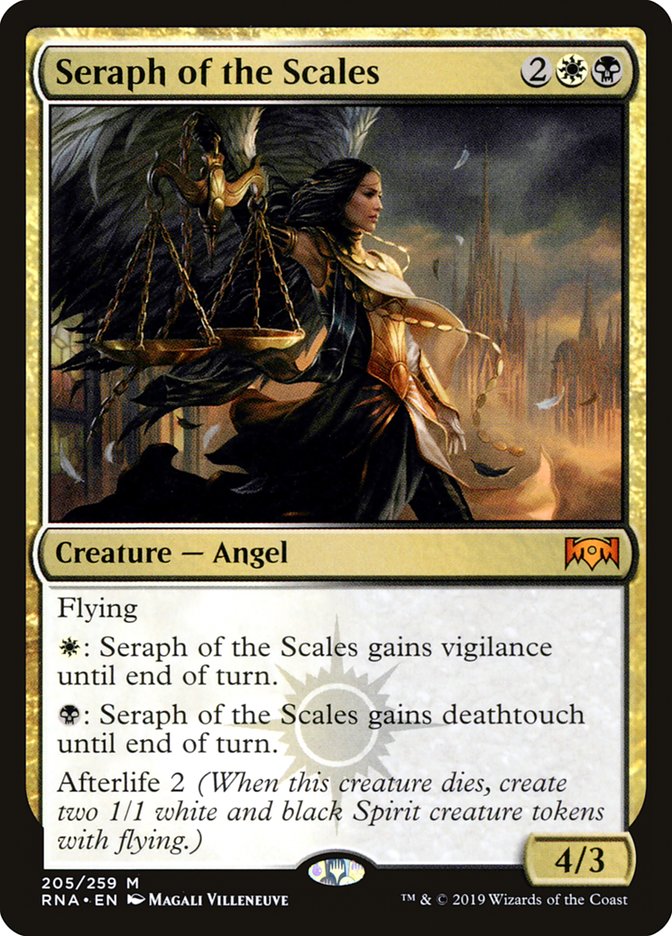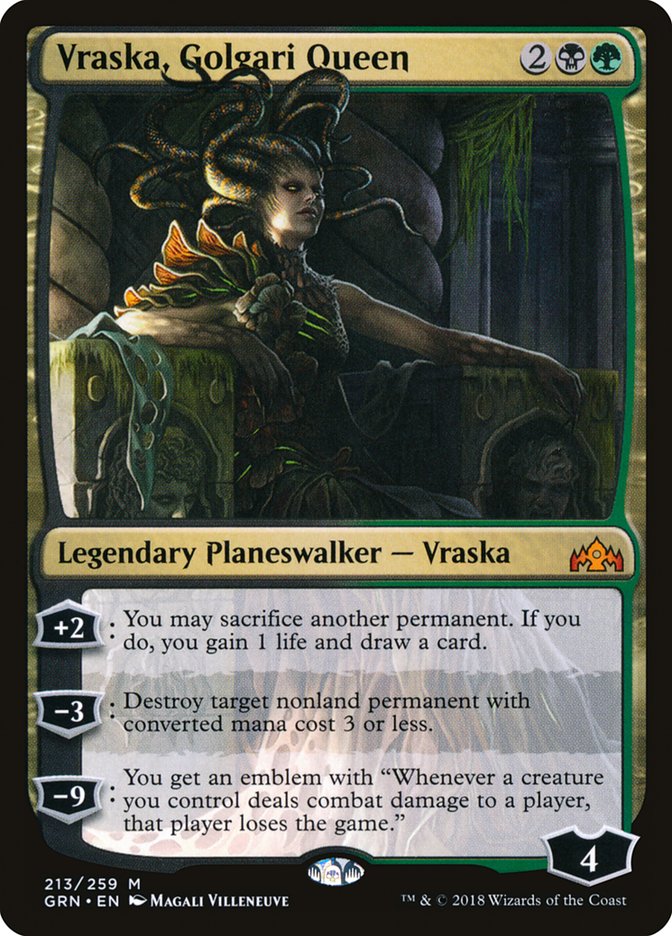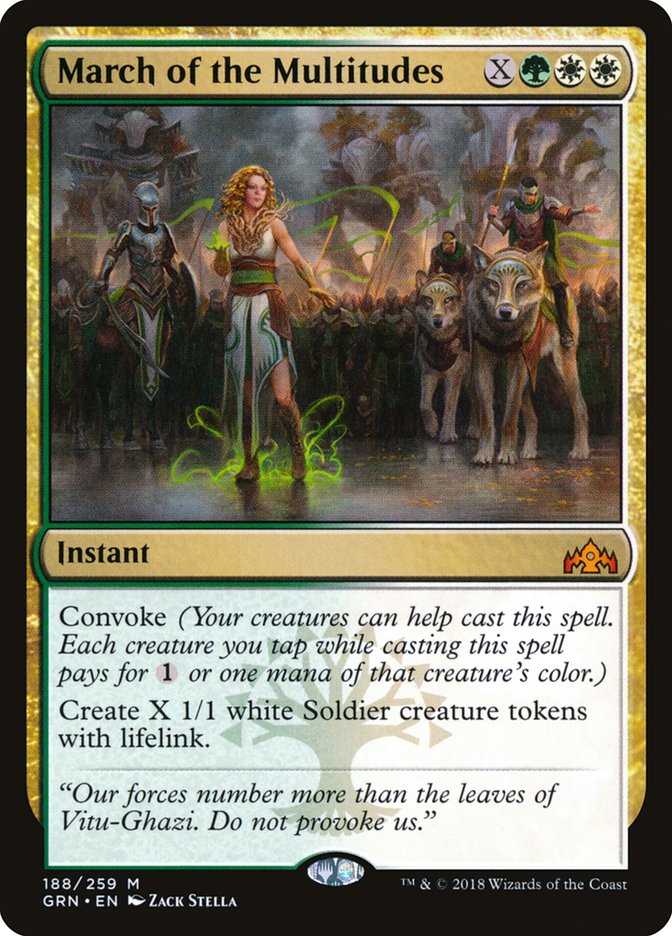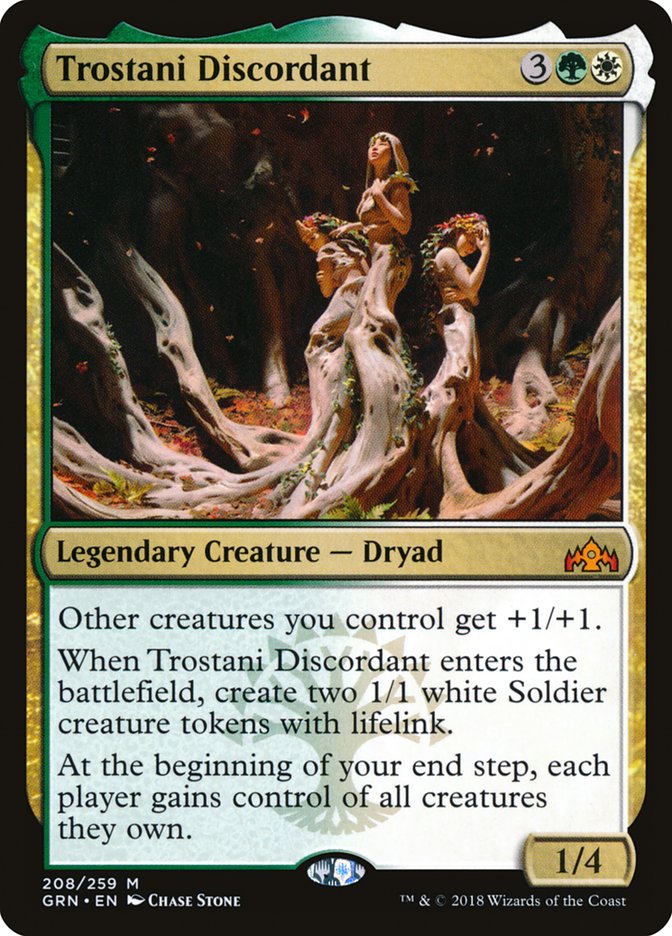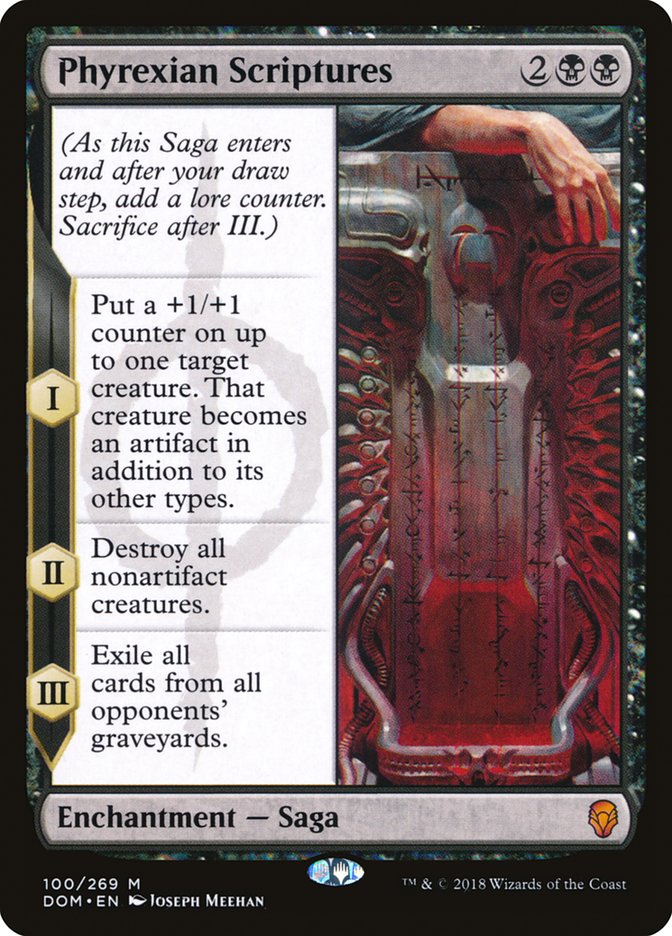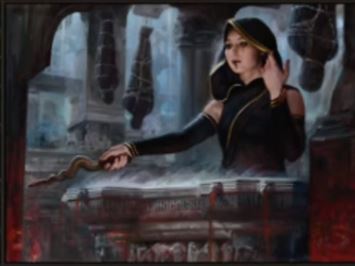Last week, Wizards of the Coast previewed Judith, the Scourge Diva and
immediately set the Magic community abuzz, thinking of ideas on how to best
abuse her ability most effectively.
The most important task would be figuring out the best shell to surround
her in, typically a deck full of creatures that can provide value before
they’re destroyed or sacrificed, have the ability to recur from the
graveyard or provide some benefit on death.
Ari Lax
was more than excited to share his ideas with you all and laid a very good
groundwork for what Judith decks might look like in Ravnica Allegiance Standard, but as is typical of the fickle
nature of preview season for new sets, new cards are revealed every day
that can change entire preliminary deck ideas instantly.
Case in point…
Before I dive into Priest, I want to provide some older decklists of
Standard’s past to illustrate how important powerful sacrifice outlets are
to making decks like this work. During our last visit to Ravnica, we saw
the printing of Cartel Aristocrat in Gatecrash. In combination
with Falkenrath Aristocrat, the incredibly powerful mythic from Dark Ascension, a powerful deck (playfully dubbed “The
Aristocrats: Part 2”, was born:
Both of the Aristocrats above were strong enough on their own on rate,
especially Falkenrath Aristocrat, and the engine around it was strong
enough to create an incredibly resilient deck that attacked on a ton of
different angles. Sometimes, attacking with a fleet of flying four-power
haste creatures was good enough, while other times you could use one of
these sacrifice outlets in combination with Blood Artist to drain back
valuable life points from your opponents. And sometimes Boros Reckoner and
Blasphemous Act would team up together to cheese your opponents out of the
game with a thirteen-ball to the face.
A much more recent example of using free sacrifice outlets is the infamous
Four-Color Rally the Ancestors deck that terrorized Khans of Tarkir/Battle for Zendikar block Standard:
Creatures (28)
- 4 Nantuko Husk
- 4 Elvish Visionary
- 3 Grim Haruspex
- 3 Sidisi's Faithful
- 4 Jace, Vryn's Prodigy
- 3 Catacomb Sifter
- 4 Zulaport Cutthroat
- 3 Reflector Mage
Lands (24)
Spells (8)

Nantuko Husk first saw print all the way back in 2002’s Onslaught,
but its reprinting in Magic Origins in combination with Zulaport
Cutthroat, this version’s deck of Blood Artist and Rally the
Ancestors, created an instant speed kill engine that was almost impossible
to interact with outside of narrow cards like Hallowed Moonlight.
The sacrifice outlets in the decks above didn’t have particularly powerful
effects attached to them, but their ability to cost nothing and to be
activated at any time more than made up for it.
Priest of Forgotten Gods does not benefit from this advantage, but the
payoff for using the ability is absurdly high.
The card provides four beneficial effects as a payoff, which is hard to ignore.
Providing a mana advantage, card advantage, removal, and life drain all in
one effect makes Priest worth exploring in some capacity, because as little
as one activation can put an opposing player woefully behind.
Of note, Priest doesn’t require the creatures you sacrifice to it to be
non-token, which opens up the possibilities to build around it quite
substantially. Let’s look at a new take on tokens with Priest of the
Forgotten Gods and some other Ravnica Allegiance cards to help it
out:
Creatures (21)
- 4 Emmara, Soul of the Accord
- 3 Trostani Discordant
- 4 Seraph of the Scales
- 2 Teysa Karlov
- 4 Hero of Precinct One
- 4 Priest of Forgotten Gods
Planeswalkers (2)
Lands (24)
Spells (13)

While this list is a rough draft, the concept of the deck in theory is to
utilize robust and/or repeatable token generation to help grind opponents
out using Priest of Forgotten Gods. Priest’s payoff being so high will make
it a high value removal spell target, so the idea of this shell is to make
sure the rest of it resilient enough to where it can play without it while
also being impossible to catch up with if left uncontested. A secondary
subtheme of this list is the engine of Hero of Precinct One and
multicolored spells to provide fodder for Priest, and if you’re wondering
why I didn’t include History of Benalia, this would be my reasoning.
Whether it’s correct or not I cannot say since this list is theoretical and
untested – and History is absurdly powerful – but the multicolor cards of
choice all help push a tokens style strategy well without having to play
cards that feel weak on their own.
Seraph of the Scales is a powerful standalone threat with a ton of text on
it, but the afterlife 2 line is most important in this shell as it provides
a ton of value when sacrificed to the Priest. Emmara, Soul of the Accord is
a centerpiece of one of Standard’s most powerful strategies of current,
providing a steady stream of Soldier tokens if left uncontested.
Vraska, Golgari Queen sees fringe play in current Standard’s Golgari lists,
but the +1 ability felt underwhelming as you would sometimes be sacrificing
“real” cards to provide value. In this list, there’s a steadier stream of
expendable resources to make use of this ability instead.
March of the Multitudes and Trostani Discordant, like Emmara, provide an
absurdly powerful and occasionally game ending sequence when played in
tandem, and Mortify’s return to Standard gives the deck a cheap and
universally powerful removal spell to deal with the harder to deal with
creatures and enchantments in the format.
I could see a shell using Priest of Forgotten Gods and Hero of Precinct One
coming to fruition as a force in Ravnica Allegiance Standard, as
both can cause a runaway in a game on their own and work incredibly well in
tandem.
At SCG CON Winter, Jim Davis showed up with a fairly unique Rakdos Midrange
deck that utilized resilient creatures and/or ones with enters the
battlefield effects alongside cards like Arguel’s Blood Fast and
Plaguecrafter to sacrifice those creatures for additional value. Naturally,
this was another type of deck that seemed like a good fit for Priest of
Forgotten Gods.
Creatures (30)
- 4 Siege-Gang Commander
- 4 Rekindling Phoenix
- 2 Ravenous Chupacabra
- 4 Dusk Legion Zealot
- 4 Goblin Instigator
- 4 Midnight Reaper
- 4 Plaguecrafter
- 4 Priest of Forgotten Gods
Planeswalkers (3)
Lands (24)
Spells (3)

I did little to Jim’s original decklist aside from add in Priest, but one
thing I did also change was move to the full set of Goblin Instigator.
Instigator and Priest work incredibly well together, as the two creatures
provided by the Instigator allow for immediate processing by the Priest. A
potential line on the third turn of the game after deploying Priest on turn
2 is to cast an Instigator, sacrifice both new creatures, removing a
potential creature, drawing a card, and allowing you to power out another
play, like Midnight Reaper or Plaguecrafter. I think this example is a good
time to drive home the fact that the mana advantage provided by Priest of
Forgotten Gods is likely the most powerful one, as it allows you to power
out threats very far ahead of schedule in certain scenarios. Phyrexian
Tower this card is not, but it can get pretty close to imitating it with
enough help.
There’s a lot of room for deckbuilding with Priest of Forgotten Gods. The
tools are all absolutely there, between token generators, Gruesome
Menagerie, and a slew of cards that provide heaps of value when they’re
sacrificed. The number one concern on this card, as always, is whether the
set up cost is too much or if the engine is too slow. At two mana, I wager
that it isn’t, and it will likely see play in a shell similar to the Abzan
Tokens list above, one that doesn’t have to entirely revolve around the
card but will benefit greatly when it actually gets to make use of the
effect. Add this card to the list of previewed cards in Ravnica Allegiance with a ton of potential, just begging to be
broken.
Additionally, can we take a second to bring up the fact that this card definitely references the Phyrexians? Between the art and the
ability itself – again, if this isn’t a nod to Phyrexian Tower I will eat
my nonexistent hat – the Vorthos in me is wondering why there would be
worshippers of Yawgmoth on Ravnica, and the conspiracy theorist in me hopes
it’s because we might be making a trip to Mirrodin sometime soon.
Hmm…


